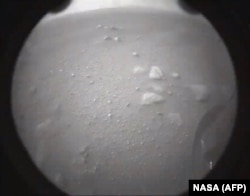NASA says its Perseverance aircraft has successfully landed in a Mars crater named after the Bosnian town of Jezero -- the third visit to the red planet in just over a week.
The six-wheeled vehicle -- the biggest, most advanced rover ever sent by NASA – touched down on February 18 after a seven-month, 470-million-kilometer journey from Earth.
It was designed to hit the thin Martian atmosphere at 19,500 kilometers per hour, then use a parachute to slow it down, and a rocket-steered platform to lower the rover the rest of the way to the surface.
NASA is teaming up with the European Space Agency to bring rocks from Mars that could answer whether life ever existed on the planet.
It is a historic day for the 1,000 residents of the Bosnian town of Jezero, whose name was given by the International Astronomical Union in 2007 to the 49-kilometer-wide crater thought to have once been flooded with water.
Jezero, which means “lake” in some Slavic languages, is located on Pliva Lake.
The car-size, plutonium-powered Perseverance rover is the ninth spacecraft to successfully land on Mars -- all of them from the United States.
Two spacecraft from the United Arab Emirates and China were put into orbit around the planet last week.
China’s spacecraft includes a smaller rover that also will be seeking evidence of life if it successfully lands on Mars later this year.
All three missions departed the Earth in July to take advantage of the planet's close alignment to Mars.

